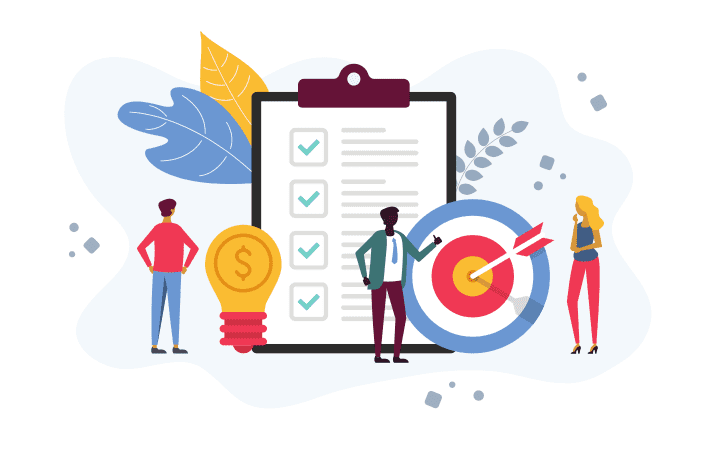Transform Your Surveys from Snooze-Fest to Success Story
Employee engagement is the secret weapon for productivity and a thriving company culture. However, most employee engagement surveys are as thrilling as watching paint dry. 🥱
It’s time to ditch the generic questionnaires and create surveys that actually make a difference. It’s time to inject a little spark into the feedback process. And hey, we’ve got a free template to kickstart your efforts!
1. Cracking the Code: Define Your Survey Goals
Before bombarding your employees with questions, channel your inner Sherlock Holmes and define the case you’re trying to crack. 🕵️♀️
- What’s the mystery you’re trying to solve? Are you seeking a general sense of engagement or specific areas to investigate (e.g., leadership, work-life balance)?
- What clues do you need to uncover? What specific insights will unlock the secrets to employee engagement?
- How will you use your newfound knowledge? Will you share it with the team, make data-driven changes, or file it away?
Defining your goals focuses on your questions, preventing aimless wandering through a maze of data.
2. The Art of Asking (Without the Interrogation)
Survey questions are your team of detectives – they can either help you uncover the truth or leave you with more questions than answers. Here are the main types to include:
- Likert Scale: Gauge satisfaction on a numerical scale (e.g., “On a scale of 1 to 5, how satisfied are you with your work-life balance?”)
- Open-Ended: Encourage detailed feedback (e.g., “What’s one change we could make to improve your work experience?”)
- Multiple Choice: Offer options for specific insights (e.g., “Which of the following professional development opportunities would you most value?”)
Craft questions that are clear and concise and avoid leading language. Keep your survey brief to respect your employees’ time.
3. Launching Your Feedback Express: Implementing Your Survey
Choosing the right survey tool is crucial. Sogolytics, an employee experience survey software, offers a user-friendly platform with a free employee engagement survey template. Its features – data analysis, reporting, anonymity options – streamline the survey process.
In addition to choosing the right software, timing is key. Avoid launching your survey during busy periods or holidays, as you don’t want your employees to feel ambushed.
4. Analyzing the Evidence: Turning Data into Action
Once your survey is complete, it’s time to examine the evidence. Sogolytics (or your chosen tool) makes it easy to analyze the data and identify trends. Be transparent with your employees about the results. Highlight the good, the bad, and the areas with room for growth. This shows them that you value their feedback and are committed to improvement.
5. The Big Reveal: Your Employee Engagement Action Plan
Remember, an employee engagement survey is just the beginning. It’s what you do with the insights that matters. Develop an action plan based on the feedback received, and involve your employees in the process. This creates a sense of ownership and boosts engagement.
Taking Action Based on Survey Feedback
Now for the grand finale: it’s time to translate insights into impact. Here’s how:
- Prioritize: Not every issue can be tackled at once. Focus on the areas with the biggest impact on employee satisfaction and engagement.
- Collaborate: Don’t just tell employees what you’re doing; involve them in brainstorming and implementing solutions.
- Communicate: Keep employees updated on the progress of your action plan. Celebrate successes and acknowledge challenges.
- Measure & Iterate: Use follow-up surveys (or pulse surveys) to track progress and fine-tune your efforts.
Continuous Improvement: The Never-Ending Story
Employee engagement isn’t a one-and-done deal. It’s an ongoing journey of listening, learning, and adapting. Make employee surveys a regular part of your company culture, and watch as your team becomes more engaged, productive, and fulfilled.
Conclusion: The Case of the Happier Employees is Solved!
Ready to crack the code to a more engaged workforce? Download the free employee engagement survey template from Sogolytics and start your investigation! 🔍
FAQs
Q1. How often should we conduct employee engagement surveys?
- A1: The ideal frequency depends on your company’s size and needs. However, annual or bi-annual surveys are a good starting point. You can also conduct pulse surveys (shorter, more frequent surveys) to gauge sentiment on specific topics.
Q2. Should employee engagement surveys be anonymous?
- A2: Anonymity encourages honest feedback. However, consider offering an optional section for employees to identify themselves if they’d like to discuss their responses further.
Q3. What are some common mistakes to avoid when creating employee engagement surveys?
- A3: Avoid leading questions, overly complex language, and surveys that are too long. Ensure your survey focuses on actionable feedback, not just collecting data for the sake of it.
Q4. How can I ensure a high response rate for my employee engagement survey?
- A4: Clearly communicate the survey’s purpose, and how the results will be used, and emphasize the confidentiality of responses. Consider offering incentives (like a raffle or extra break time) to encourage participation.

